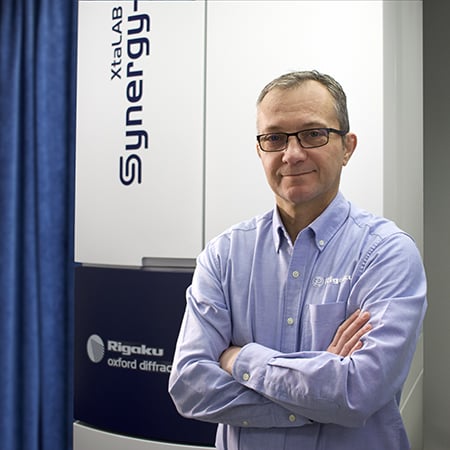Application Note PX020
Introduction
Protein crystallography often requires screening large numbers of crystals to identify samples that are suitable for X-ray diffraction experiments. Specifically, crystallographers usually loop and cryofreeze samples for X-ray screening to identify whether the sample contains a protein or salt and to evaluate diffraction resolution, mosaicity and other crystal parameters. This iterative process of mounting and screening of many samples is time-consuming and rarely automated.
The XtalCheck-S system addresses this bottleneck by automating diffraction data collection for crystals directly from SBS-format crystallization plates. With the XtalCheck-S system, one can quickly and easily survey many crystallization experiments by eliminating the need to harvest and cryo-protect samples. Moreover, one can perform complete crystallography experiments, by collecting data from multiple crystals in random orientations, to achieve complete data sets that can be used for structure solution.

Figure 1: XtaLAB Synergy-R system with XtalCheck-S.
Screening crystals with CrysAlisPro
The XtalCheck-S was mounted on a XtaLAB Synergy-DW with a 4-circle kappa Universal Goniometer 2 and a HyPix6000-HE Hybrid Photon Counting detector. Lysozyme crystals were grown in an In Situ-1™ crystallization plate (MiTeGen). Figure 2 shows the CrysAlisPro interface with object selection and a data collection image for an example crystal.

Figure 2: CrysAlisPro interface and results for in situ screening of an In Situ-1 crystallization plate.
Imaging and X-ray diffraction data collection of lysozyme crystals
Lysozyme crystals were grown in an In Situ-1 crystallization plate (MiTeGen). Figure 3 shows drop images for six conditions, showing crystals of varying morphologies and sizes. Six crystal objects were selected for data collection in a queue. Then, data were collected automatically for the series of samples without user intervention.

Figure 3: Visible images, captured using the CryAlisPro software, for six crystals located in wells A8, H2, H7, H8, and H9. These crystals were further characterized by X-ray diffraction.
For each crystal, a total of 40° of data were collected using an exposure time of 20 seconds per 0.5° and 2θ = 22°. Of these, all exhibited protein-like diffraction up to ~1.8 Å (Figure 4).

Figure 4: Diffraction images for all six lysozyme crystals. The highest resolution is 1.72 Å in the corner.
Data processing and molecular replacement for lysozyme crystals
Following data collection, each scan was processed individually and then scaled together without issue in CrysAlisPro. Afterwards, the data were passed through AIMLESS¹ in CCP4i² and the resulting statistics are reported in Table 1. The data set looked complete to 1.8 Å, with good values for mean signal-to-noise ratio, Rmerge, Rmeas, and CC½. The completeness of the combined scans was 98.1% and 86.7% for all data and the highest- resolution shell, respectively. The structure was solved by molecular replacement using only the backbone of PDB ID 1LYZ as a search model in the phasing pipeline of HKL-3000³ (which used MOLREP⁴). The resulting MR solution was rebuilt using ARP/wARP⁵ and refined with REFMAC⁶ to produce a model with an R=15.0% and Rfree=19.5% (Figure 5). The anomalous difference map had strong peaks on the sulfur atoms.
Table 1: Data processing summary for merged lysozyme data
| Space group | P4₃2₁2 |
| Avg. unit cell lengths (Å) | 79.5, 79.5, 37.9 |
| Resolution (Å) (last shell) | 28.09 – 1.80 (1.84 – 1.80) |
| # reflections / # unique | 69674 / 11485 |
| Completeness (%) (last shell) | 98.1(86.7) |
| Multiplicity (last shell) | 6.1 (2.3) |
| <I/σI> (last shell) | 17.3 (1.7) |
| Rmerge (%) (last shell) | 5.8 (40.5) |
| Rmeas (%) (last shell) | 6.3 (49.6) |
| CC½ (%) (last shell) | 99.9 (77.8) |

Figure 5: Electron density maps and model near Trp111(*). 2Fo-Fc after refinement (blue mesh @ 2 rmsd), Fo-Fc (red and green meshes @ 3 rmsd), and anomalous difference (magenta mesh @ 4 rmsd).
Conclusions
Here we describe serial data collection for several crystals using the XtalCheck-S system. A complete data set to 1.8 Å was collected in under three hours using six different lysozyme crystals in five drops in a MiTeGen plate using the XtalCheck-S mounted on a XtaLab Synergy-DW. These results illustrate that the XtalCheck-S allows you to go beyond screening—you can collect full data sets by collecting sweeps on several crystals. Moreover, the complete lysozyme data set had excellent statistics and produced a high-quality model with excellent R factors after molecular replacement solution.
References
[1] CCP4. (2011) Acta Cryst. D67, 235-242.
[2] Evans, P.R. & Murshudov, G.N. (2013) Acta Cryst. D69, 1204-1214.
[3] Minor W., Cymborovski M., Otwinowski, Z. & Chruszcz, M. (2006) Acta Cryst. D62, 859-866.
[4] Vagin A.A.& Teplyakov A. (1997) J. Appl. Cryst. 30, 1022-1025.
[5] Langer G., Cohen S.X., Lamzin V.S. & Perrakis, A.(2008) Nature Protocols. 3, 1171-1179.
[6] Murshudov G.N., Vagin A.A. & Dodson E.J. (1997) Acta Cryst. D53, 240-255.

